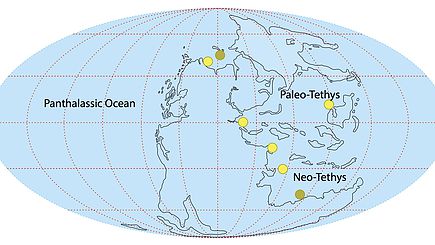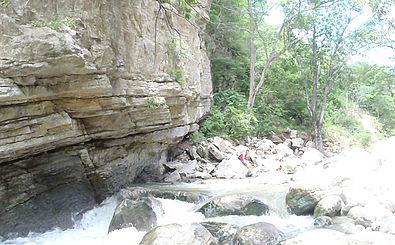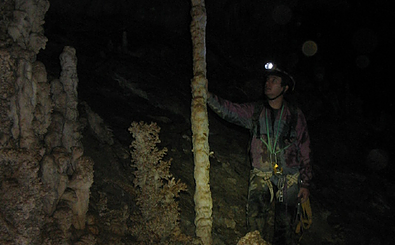Research

Evolution of Cenozoic tropical Carbonate platform
This research focusses on timing changes in the Cenozoic marine carbonate factories along the tropical Circum-Caribbean. The combination of precise carbonate U-Pb geochronology and (C-O) stable and radiogenic (87Sr/86Sr) isotope stratigraphy has improved our understanding of the relationship between major changes in the Cenozoic carbonate factories and global climatic events i.e., the onset and expansion of the Antartic ice sheets (Silva et al. submitted). We have further related changes in the occurrence of coral reefs to major tectonic events (i.e., exhumation of the Andes and the closure of the Panama seaway).This research has also allowed precisely dating the opening and evolution of several sedimentary basins along convergent margins, i.e. the SE Circum Caribbean (Colombia, Venezuela, Panama). As the opening of several of these sedimentary basins is closely related to the interaction between the Caribbean and South American plates, this research has also contributed to the Cenozoic paleogeographic reconstruction of northern South America and the Caribbean.
The combination of U-Pb dating, chemostratigraphy and sequence stratigraphy have been final successfully used to date Cenozoic carbonate oil and gas reservoirs. In addition, it has provided necessary background dataset for characterizing the occurrence of potential siliciclastic and carbonate oil and gas reservoirs in frontier basins along northern South America and the Circum-Caribbean region.
This research is being conducted in collaboration with internationally recognized scientists from the Institute of Ocean Research Geomar (Germany), Smithsonian Tropical Research Institute (Panama), Universidade Federal de Pernambuco (Brazil), National University of Colombia (Medellin, Colombia), Universidad de Caldas (Colombia), Andes University (Colombia).
This research has been funded by the Smithsonian Tropical Research Institute in Panama as well as by several oil and gas companies including, the Colombian Petroleum Company, Colombian National Hydrocarbon Agency, PETROBRAS, REPSOL, Gran Tierra, Hocol and Pacific Rubiales.

Ocean acidification and dexigenation during periods of high atmospheric pCO2
I have integrated carbonate sedimentology, petrography and stratigraphy with both traditional and non-traditional stable isotope geochemistry to investigate and quantify the effects of past environmental change on global biogeochemical cycles.I am currently using Mo, U, S and C stable isotopes; along with iron speciation and elemental geochemistry, to quantify the extent of ocean oxygenation during different intervals of the Earth history experiencing major biological crises and diversifications (e.g., Ediacaran, Precambrian-Cambrian boundary, the Permian-Triassic, the OAE I and II). I am also using a multi-proxy stable isotope approach involving d44/40Ca, d18O, d88/86Sr, 87Sr/86Sr to investigate the relationship between major extinction events and the effects of rapid changes in atmospheric pCO2, global warming and ocean acidification on the marine carbonate budgets (e.g., Snowball Earths, Ediacaran-Cambrian, Permian-Triassic, Cretaceous Oceanic Anoxic Events- OAEs).
These research projects are providing important information to forecast the effects of three major environmental concerns of the global societies i.e., global warming, ocean acidification and expansion of the oxygen minimum zones in the global oceans.
These projects are being conducted in collaboration with globally recognized scientists from different universities, including Stanford University (USA), Kiel University-Geomar Institute (Germany), University of California Santa Cruz (USA), Leeds University (U.K.), Hannover University (Germany), Munster University (Germany), Curtin Technologic University (Australia), Universidade Federal de Pernambuco (Brazil), Universidade de Sao Paulo (Brazil), Graz University (Austria), Universidad de Caldas (Colombia), Universidad Nacional de Colombia. These research projects have been funded by the Swiss National Science Foundation and are currently funded by the European Union throughout the Marie Curie FP7 Actions program. The integration of geochemistry and carbonate sedimentology has captured the attention of the oil and gas industry, and further funding is thus being sought throughout joint ventures with this industry.

Characterization of Cretaceous carbonate successions along the Circum Caribbean
Cretaceous marine carbonates have become an important target in several mature and frontier basins in northern South America and the Caribbean. The evolution of Cretaceous sedimentary basins in northern South America seems to have been related to the re-activation of former tectonic structures associated to the development of proto-Caribbean and Gulf of Mexico basins. Timing of the opening of these sedimentary basins has remained difficult due to the lack of a high-resolution age controls of the sedimentary record, something that has affected our ability to identify and predict the occurrence of economically important oil and gas generating rocks and reservoirs.In this project we integrate field mapping, sequence stratigraphic characterizations, petrographic analyses, detailed C-, O- and Sr- isotope stratigraphy and bioestratigraphic information to precisely date several carbonate - black shale successions in several Colombia Cretaceous basins. Our multiproxy approach allows suggesting the opening of a major north to south epicontinental seaway during the Cetaceous, similar to the modern Black Sea; and limited by the ancestral Central Cordillera-Santa Marta massif of Colombia (to the west) and the Guyana Shield (to the east). Variations in depositional systems allow suggesting a consistent deepening of the sedimentary environments towards the south and the central part of the Colombia seaway.
Our multi-pronged approach also allows identifying the occurrence of several of the Cretaceous Oceanic Anoxic Events (OAEs) in carbonate units from the northern part of this paleo-seaway, i.e. Weissert-OAE-(Palanz and Rosablanca Formations), Faraoni-(Rosablanca Formation), AOE1a-(Paja and Fomeque Formations, Cogollo Group), OAE1c-(Cogollo Group), OAE2-(Cogollo Group), OAE3-(La Luna Formation). These events are preserved in highly euxinic - organic rich “black shales” successions deposited along the deepest part of the seaway at the Middle Magdalena Valley and Cundinamarca Basin; Weiser-OAE-(Lutitas de Macanal Formation), OAE1a-(Paja Formation, Fomeque Formation), OAE1C-(San Gil Formation). The preservation of the OAEs in eastern Colombia will allow using non-traditional stable isotopes (i.e. Mo and U) to investigate variations in the ocean oxygen levels during these periods of environmental and biologic crises.
This research has been funded by the Smithsonian Tropical Research Institute in Panama as well as by several oil and gas companies including, the Colombian Petroleum Company, Colombian National Hydrocarbon Agency, PETROBRAS, REPSOL, Gran Tierra, Hocol and Pacific Rubiales.

Holocene paleoclimate along the Neotropical Americas
The 20th century has witnessed an exponential increase in anthropogenic CO2 emissions to the atmosphere. Investigating the consequences of anthropogenic (industrial) CO2 emissions on global climate is a key research priority for the international community. In recent years, particular attention has been given to the possible future effects of increased anthropogenic CO2 emissions on the marine and continental ecosystems, as well as on the global water resources as their impairment may put at risk the global population.In 2012, I started investigating the Holocene climate variability along the tropical northern South America. This research will complement my research on long-term consequences of environmental change (Item 1) as it focuses in short-term scales comparable to that of the Anthropocene. In association with Professor Francisco Cruz (University of Sao Paulo, Brazil) I am using U-series dating and stable O and C isotope time series in speleothems (i.e., stalagmites) to investigate climate variability as well as changes in atmospheric pCO2 and rain regimes in the Neotropics.
In collaboration with palynologists and paleolimnologists from the Caldas University (Professor Andres Pardo), I am contrasting changes in the stable carbon isotope composition of organic rich sediments from high altitude lakes with their palynologic records to relate changes in high altitude vegetation along the northern Andean Chain (one of the major biosphere and megadiversity reserves in the world) to climate variability.
In close collaboration with Professors from the Universidad Nacional de Colombia (Medellin, Colombia) this research is also contributing to the investigation of the possible socio-political effects that past climate and environmental changes had on the development of several pre-Hispanic cultures in central and eastern Colombia.
This research has been conducted with the financial support of the UNESCO (Man and Biosphere Program). It has also received financial support from the Brazilian Research Council.


